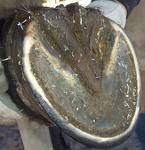 The barefoot horse movement and its veterinary researchers have come up with a reliable way to tell whether a horses barefoot hoof is well-trimmed overall.
The barefoot horse movement and its veterinary researchers have come up with a reliable way to tell whether a horses barefoot hoof is well-trimmed overall.
Traditionally, people understood the importance of breakover to a horse’s best athletic movement and to long-term soundness. Since the early 1900’s, when cars replaced horses as the main means of transportation, this understanding got lost. The movement of most horses deteriorated as the “long-heeled” barefoot trimming became the style in farrier schools. In recent decades, many horse-people have almost never seen a horse moving well. When I first saw my mare’s feet start to land correctly, I thought it looked “artificial”!
The indicator of a good horse hoof trimming is that when going on level ground, the front feet land heel-first. Just before the heel lands, you can see the foot “flip” forward as all joints in the leg go into complete extension.
In a horse with an imbalanced foot, the toe lands first, or the foot may land flat. With toe-first landing, you will see a little “wiggle” in the pastern bones — you can almost hear them go “ka-chunk” — as the horse puts weight on the foot.
The hind leg joints bend differently from the front leg joints, so that the hind leg lands heel-first almost irregardless of how the foot is natural hoof trimmed. When I talk about how to trim a foot to get it to land heel-first, I am talking about the front feet. We don’t trim the hind feet this way because they don’t need it, except in the unusual situation where the toe has gone long-out-in-front; in this case we can use the trim method temporarily until the toe has been backed-up closer to the coffin bone.
We can see the difference between heel-first and toe-first landing by walking the horse downhill and then uphill on a slight slope.
Click here for the rest of this interesting article I found at Barefoot for Soundness.
Chris Freeman

Accounts Manager
I am responsible for the accounting at EasyCare. My responsibilities require me to manage accounts payable, accounts receivable, purchasing, receipt of inventory and international order processing.




